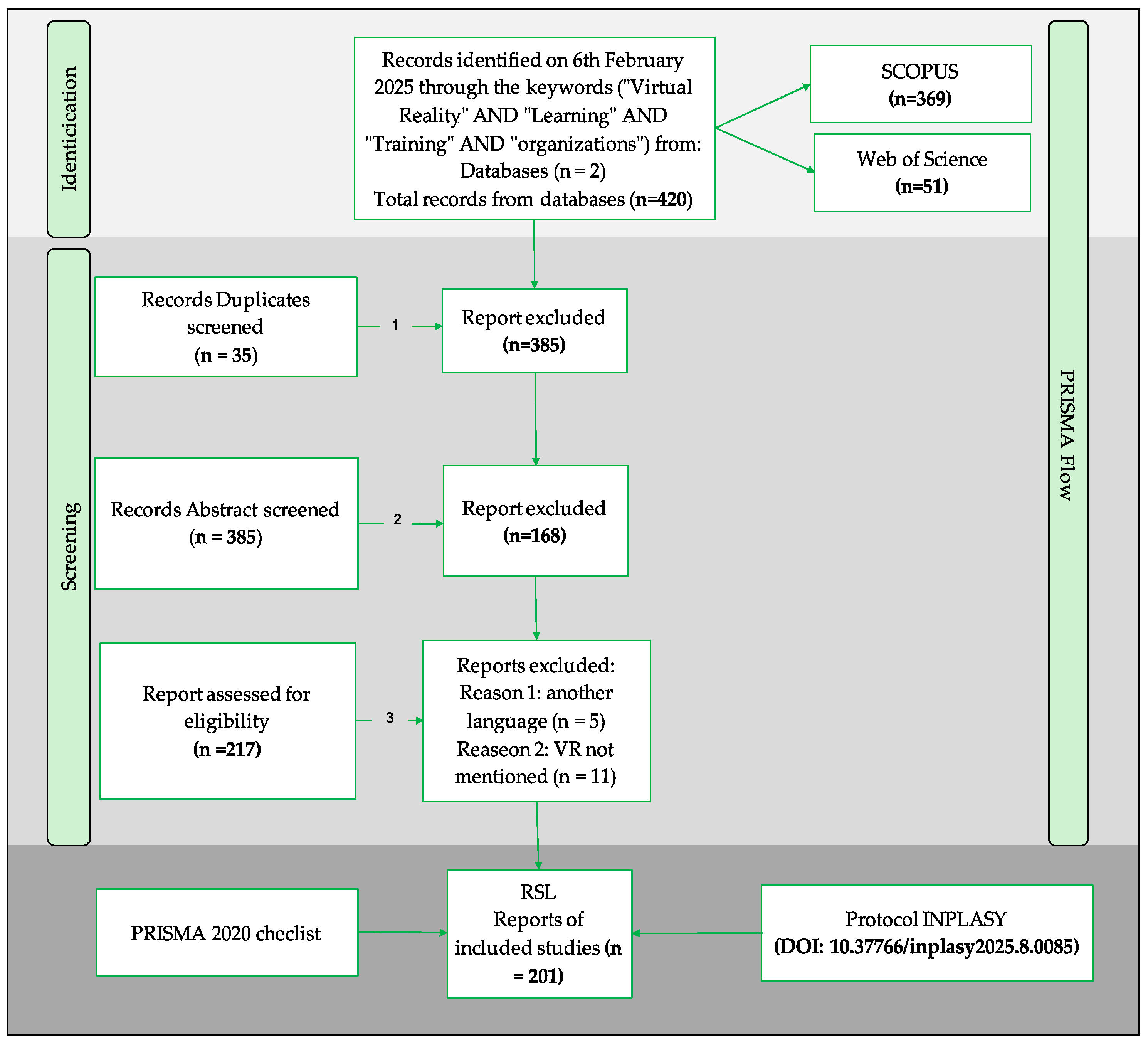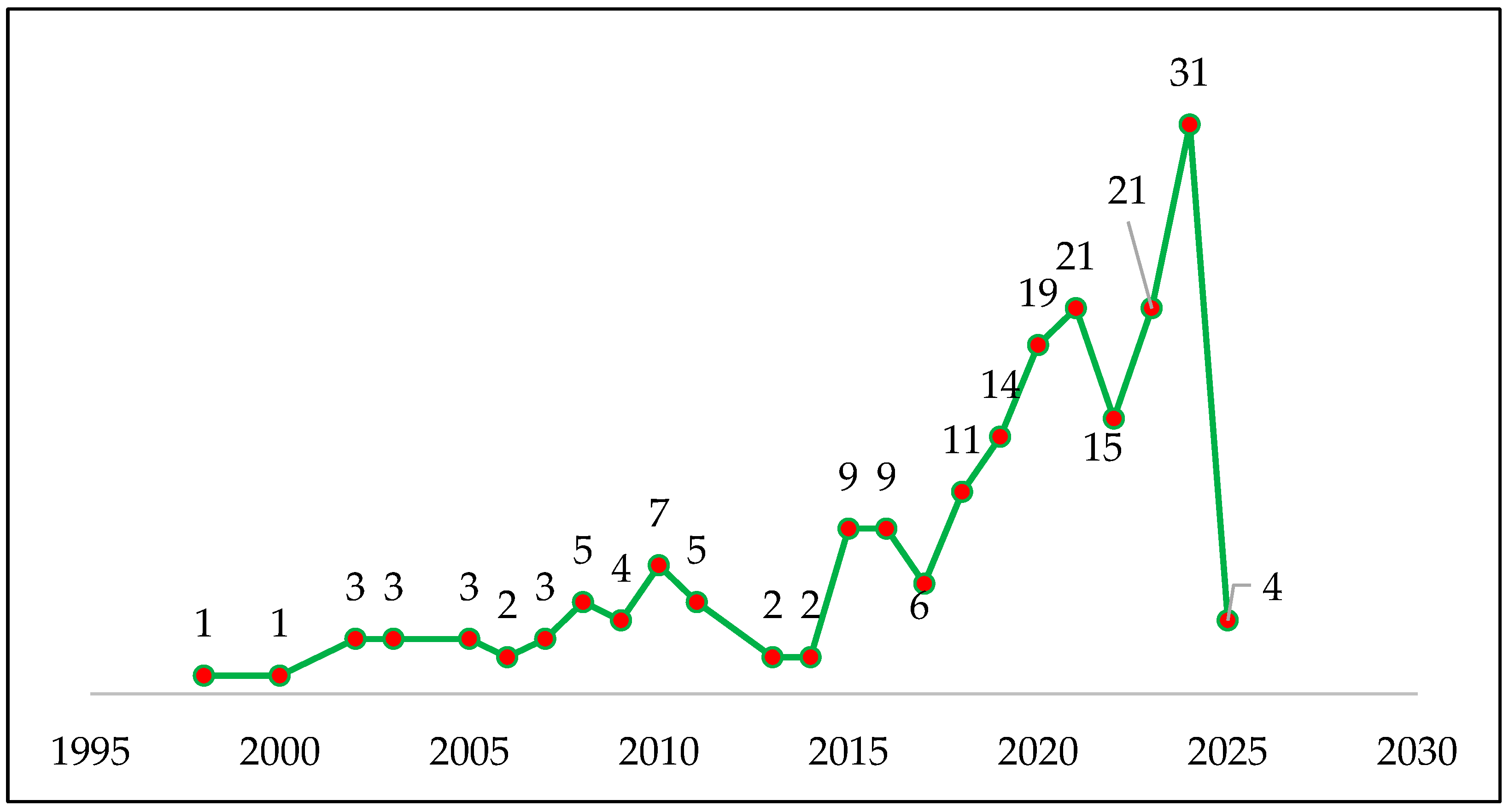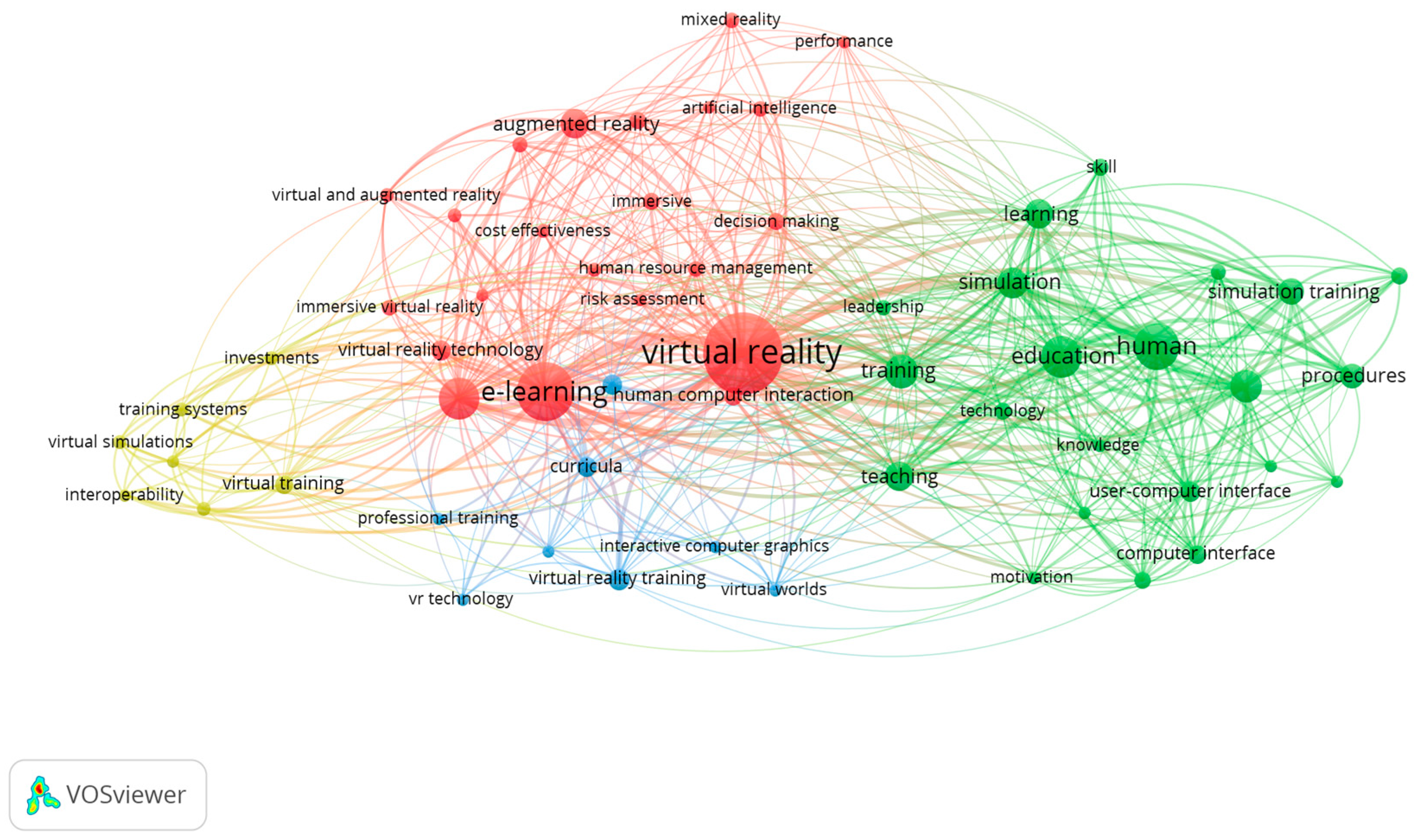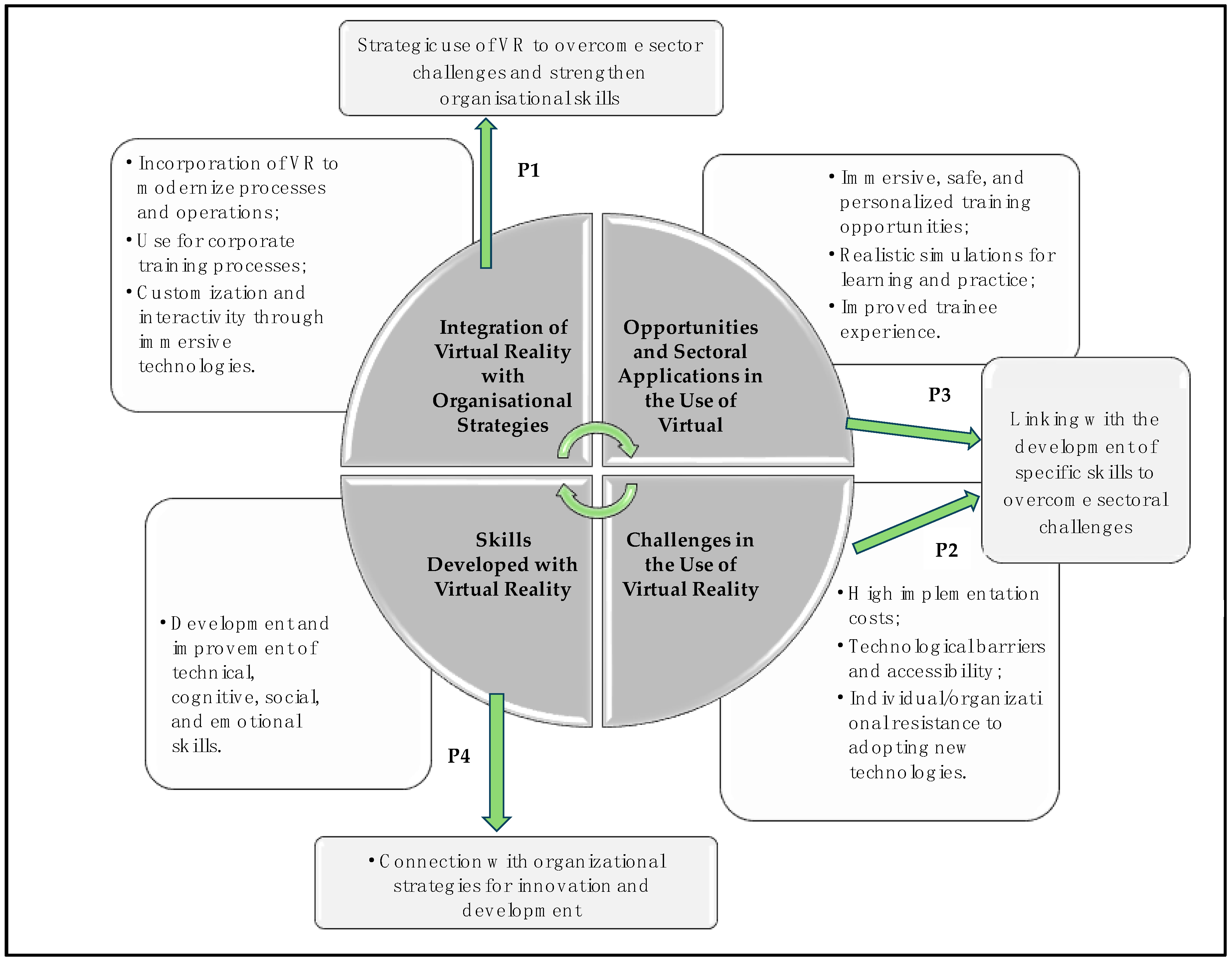The Impact of Virtual Reality on Employee Training and Learning in Organisations: A Systematic Literature Review
Abstract
1. Introduction
2. Materials and Methods
3. Results
3.1. General Results
3.2. Thematic Groups
3.2.1. Opportunities and Sectoral Applications in the Use of Virtual Reality (Cluster 1)
3.2.2. Challenges of Using Virtual Reality (Cluster 2)
3.2.3. Skills Developed with Virtual Reality (Cluster 3)
3.2.4. The Integration of Virtual Reality with Organisational Strategies (Cluster 4)
3.3. Conceptual Model
3.3.1. The Influence of Virtual Reality on Organisations
3.3.2. Challenges and Opportunities in the Use of Virtual Reality in Organisations
3.3.3. Virtual Reality and Its Connection with Innovation and Development Strategies
3.3.4. VR and Different Sectoral Applications
4. Study Limitations and Suggestions for Future Research
5. Conclusions
Funding
Institutional Review Board Statement
Informed Consent Statement
Data Availability Statement
Acknowledgments
Conflicts of Interest
References
- Lytovchenko, I.; Terenko, O.; Lavrysh, Y.; Ogienko, O.; Avsheniuk, N.; Lukianenko, V. Training delivery methods implemented by American companies: Opportunities and challenges in context of knowledge society. Postmod. Open. 2022, 13, 187–198. [Google Scholar] [CrossRef]
- Bale, A.S.; Patil, M.; Prathima, M.G.; Telgane, S.V.; Ghorpade, N.; Anish, B. Augmenting knowledge management with immersive technologies: Exploring transformative use cases for AR and VR. In Proceedings of the 2024 International Conference on Advances in Computing, Communication and Applied Informatics (ACCAI), Chennai, India, 9–10 May 2024; IEEE: New York, NY, USA, 2024; pp. 1–6. [Google Scholar] [CrossRef]
- Chang, A.A.; Kazemi, E.; Esmaeili, V.; Davies, M.S. The effectiveness of virtual reality training: A systematic review. J. Organ. Behav. Manag. 2023, 44, 214–232. [Google Scholar] [CrossRef]
- Schulz, F.; Nguyen, Q.; Baetzner, A.; Sjöberg, D.; Gyllencreutz, L. Exploring medical first responders’ perceptions of mass casualty incident scenario training: A qualitative study on learning conditions and recommendations for improvement. BMJ Open 2024, 14, e084925. [Google Scholar] [CrossRef] [PubMed]
- Hussain, A.T.; Halford, E.; AlKaabi, F. The Abu Dhabi Police virtual training centre: A case study for building a virtual reality development capacity and capability. Polic. J. Policy Pract. 2023, 17, paad028. [Google Scholar] [CrossRef]
- Feenstra, T.M.; Tejedor, P.; Popa, D.E.; Francis, N.; Schijven, M.P. Surgical education in the post-COVID era: An EAES DELPHI-study. Surg. Endosc. 2023, 37, 2719–2728. [Google Scholar]
- Müller, S.; Dekker, E.; Morris Binelli, K.; Piggott, B.; Hoyne, G.; Christensen, W.; Zaichkowsky, L.; Fadde, P.; Brenton, J.; Hambrick, D.Z. Attributes of expert anticipation should inform the design of virtual reality simulators to accelerate learning and transfer of skill. Sports Med. 2023, 53, 301–309. [Google Scholar] [CrossRef]
- Dastane, O.; Rafiq, M.; Turner, J.J. Implications of metaverse, virtual reality, and extended reality for development and learning in organizations. Dev. Learn. Organ. Int. J. 2024, 38, 27–32. [Google Scholar] [CrossRef]
- Youngblood, P.; Harter, P.M.; Srivastava, S.; Moffett, S.; Heinrichs, W.L.; Dev, P. Design, development, and evaluation of an online virtual emergency department for training trauma teams. Simul. Healthc. 2008, 3, 146–153. [Google Scholar] [CrossRef]
- Duren, R., Jr. Feasibility study of using virtual reality (VR) technology as a means of leadership development. In Proceedings of the International Annual Conference of the American Society for Engineering Management, Denver, CO, USA, 25–28 October 2023; American Society for Engineering Management (ASEM): Huntsville, AL, USA, 2023. [Google Scholar]
- Lele, A. Virtual reality and its military utility. J. Ambient. Intell. Humaniz. Comput. 2013, 4, 17–26. [Google Scholar]
- Satava, R.M. Virtual reality surgical simulator: The first steps. Surg. Endosc. 1993, 7, 203–205. [Google Scholar] [CrossRef]
- Pedram, S.; Ogie, R.; Palmisano, S.; Farrelly, M.; Perez, P. Cost–benefit analysis of virtual reality-based training for emergency rescue workers: A socio-technical systems approach. Virtual Real. 2021, 25, 1071–1086. [Google Scholar] [CrossRef]
- Radianti, J.; Majchrzak, T.A.; Fromm, J.; Wohlgenannt, I. A systematic review of immersive virtual reality applications for higher education: Design elements, lessons learned, and research agenda. Comput. Educ. 2020, 147, 103778. [Google Scholar] [CrossRef]
- McGovern, E.; Moreira, G.; Luna-Nevarez, C. An application of virtual reality in education: Can this technology enhance the quality of students’ learning experience? J. Educ. Bus. 2020, 95, 490–496. [Google Scholar] [CrossRef]
- Brown, R.; Sitbon, L.; Fell, L.; Koplick, S.; Beaumont, C.; Brereton, M. Design insights into embedding virtual reality content into life skills training for people with intellectual disability. In Proceedings of the 28th Australian Conference on Human-Computer Interaction, Launceston, Australia, 29 November–2 December 2016; ACM: New York, NY, USA, 2016; pp. 581–589. [Google Scholar] [CrossRef]
- Wyld, D.C. A virtual explosion or SNAFU is always better than a real one: Exploring the use of virtual worlds for simulation and training… and developing the leaders of tomorrow. In Technological Developments in Education and Automation; Iskander, M., Kapila, V., Karim, M., Eds.; Springer: Dordrecht, The Netherlands, 2010; pp. 73–81. [Google Scholar] [CrossRef]
- Fernandez-Espinosa, M.; Clouse, K.; Sellars, D.; Tong, D.; Bsales, M.; Alcindor, S.; Hubbard, T.D.; Villano, M.; Gómez-Zará, D. Breaking the familiarity bias: Employing virtual reality environments to enhance team formation and inclusion. In Proceedings of the 2025 CHI Conference on Human Factors in Computing Systems, Yokohama, Japan, 26 April–1 May 2025. [Google Scholar]
- Pieper, D.; Rombey, T. Where to prospectively register a systematic review. Syst. Rev. 2022, 11, 8. [Google Scholar] [CrossRef] [PubMed]
- Phoobane, P.; Masinde, M.; Mabhaudhi, T. Predicting infectious diseases: A bibliometric review on Africa. Int. J. Environ. Res. Public Health 2022, 19, 1893. [Google Scholar] [CrossRef] [PubMed]
- Knowles, M.S. From pedagogy to andragogy. Relig. Educ. 1980, 75, 202–211. [Google Scholar]
- Kolb, D.A. Experiential Learning: Experience as the Source of Learning and Development; Prentice Hall: Englewood Cliffs, NJ, USA, 1984. [Google Scholar]
- Mayer, R.E. Multimedia Learning, 2nd ed.; Cambridge University Press: Cambridge, UK, 2009. [Google Scholar] [CrossRef]
- Sweller, J. Cognitive load during problem solving: Effects on learning. Cogn. Sci. 1988, 12, 257–285. [Google Scholar] [CrossRef]
- Makransky, G.; Petersen, G.B. The cognitive affective model of immersive learning (CAMIL): A theoretical research-based model of learning in immersive virtual reality. Educ. Psychol. Rev. 2021, 33, 937–958. [Google Scholar] [CrossRef]
- Davis, F.D.; Bagozzi, R.P.; Warshaw, P.R. Technology acceptance model. Manag. Sci. 1989, 35, 982–1003. [Google Scholar] [CrossRef]
- Appelbaum, S.H. Socio-technical systems theory: An intervention strategy for organizational development. Manag. Decis. 1997, 35, 452–463. [Google Scholar] [CrossRef]
- Tretsiakova-McNally, S.; Maranne, E.; Verbecke, F.; Molkov, V. Mixed e-learning and virtual reality pedagogical approach for innovative hydrogen safety training of first responders. Int. J. Hydrogen Energy 2017, 42, 7504–7512. [Google Scholar] [CrossRef]
- Stuart, J.P.; Gannon, P.R.; Dotto, V.R.; Regina, R.; Mumma, J.M. Visualizing the WHO “My Five Moments for Hand Hygiene,” framework: A virtual reality training program for improving hand hygiene adherence among nurses. Am. J. Infect. Control 2025, 53, 576–581. [Google Scholar] [CrossRef]
- Peisachovich, E.; Appel, L.; Sinclair, D.; Luchnikov, V.; Da Silva, C. CVRriculum program faculty development workshop: Outcomes and suggestions for improving the way we guide instructors to embed virtual reality into course curriculum. Cureus 2021, 13, e13692. [Google Scholar] [CrossRef] [PubMed]
- Gonzalez Almaguer, C.A.; Acuña López, A.; Pérez Murueta, P.; Aguirre Acosta, Á.C.; Román Jiménez, O.R.; Zubieta Ramírez, C. Virtual and augmented reality to exploit STEM-skills-based learning for engineering sutents using the TEC21 educational model. In Proceedings of the DS 110: Proceedings of the 23rd International Conference on Engineering and Product Design Education (E&PDE 2021), Herning, Denmark, 9–10 September 2021. [Google Scholar] [CrossRef]
- Kaimara, P.; Deliyannis, I.; Oikonomou, A.; Fokides, E. Waking Up in the Morning (WUIM): A Smart Learning Environment for Students with Learning Difficulties. Technologies 2021, 9, 50. [Google Scholar] [CrossRef]
- Luke, N.; Keith, A.; Bajcar, N.; Sureshkumar, B.; Adebayo, O. The perceptions of university students as to the benefits and barriers to using immersive virtual reality in learning to work with individuals with developmental disabilities. Educ. Sci. 2024, 14, 812. [Google Scholar] [CrossRef]
- Willett, J.; Adelman-Mullally, T.; Ng, H.; Chung, S.Y. Virtual Reality Simulation Integration in a Prelicensure Nursing Program: Lessons Learned. Nurse Educ. 2024, 49, 217–221. [Google Scholar] [CrossRef]
- Pflieger, L.C.J.; Hartmann, C.; Bannert, M. Enhancing knowledge construction in emerging technologies: The role of imagination training in immersive virtual reality environments. Discov. Educ. 2024, 3, 65. [Google Scholar] [CrossRef]
- Rey-Becerra, E.; Barrero, L.H.; Ellegast, R.; Kluge, A. Improvement of short-term outcomes with VR-based safety training for work at heights. Appl. Ergon. 2023, 112, 104077. [Google Scholar] [CrossRef]
- Chicone, R.; Rana, S. The influence of traditional cybersecurity training on user attitudes towards VR cybersecurity training. Issues Inf. Syst. 2023, 24, 101–112. [Google Scholar] [CrossRef]
- Marcos-Pablos, S.; Juanes Méndez, J.A.; Walters, M.L. State-of-the-art technologies at the service of medical training and practice to foster Digital Health Ecosystems. In Proceedings of the Eighth International Conference on Technological Ecosystems for Enhancing Multiculturality (TEEM 2020), Salamanca, Spain, 21–23 October 2020; pp. 410–413. [Google Scholar]
- Pletz, C. Which factors promote and inhibit the technology acceptance of immersive virtual reality technology in teaching-learning contexts? Results of an expert survey. Int. J. Emerg. Technol. Learn. (iJET) 2021, 16, 248–272. [Google Scholar] [CrossRef]
- Mikhaylova, A.; Kokodey, T.; Kurbangalieva, J. Environmental engineering students’ motivation through foreign language learning in the context of digital teaching realization (on the example of Moodle virtual environment). E3S Web Conf. 2023, 431, 09012. [Google Scholar] [CrossRef]
- Augusto, B.; Rafael, S.; Coelho, M.C.; Ferreira, J. Connecting the dots between urban morphology and the air quality of cities under a changing climate: A bibliometric analysis. Sustainability 2024, 16, 18. [Google Scholar] [CrossRef]
- van Eck, N.J.; Waltman, L. Software survey: VOSviewer, a computer program for bibliometric mapping. Scientometrics 2010, 84, 523–538. [Google Scholar] [CrossRef] [PubMed]
- Bouras, C.; Triantafillou, V.; Tsiatsos, T. A framework for intelligent virtual training environment: The steps from specification to design. Educ. Technol. Soc. 2002, 5, 11–25. [Google Scholar]
- Nathanael, D.; Vosniakos, G.-C.; Mosialos, S. Cognitive task analysis for virtual reality training: The case of CNC tool offsetting. In Proceedings of the European Conference on Cognitive Ergonomics (ECCE 2010), Delft, The Netherlands, 25–27August 2010; pp. 241–244. [Google Scholar] [CrossRef]
- Kwok, P.K.; Chan, B.K.P.; Lau, H.Y.K. A virtual collaborative simulation-based training system. In Proceedings of the 10th International Conference on Computer Modeling and Simulation (ICCMS 2018), Sydney, Australia, 8–10 January 2018; ACM: New York, NY, USA, 2018; pp. 258–264. [Google Scholar] [CrossRef]
- Veronesi, G.; Dorn, P.; Dunning, J.; Cardillo, G.; Schmid, R.A.; Collins, J.; Baste, J.-M.; Limmer, S.; Shahin, G.M.M.; Toker, A.; et al. Outcomes from the Delphi process of the thoracic robotic curriculum development committee. Eur. J. Cardio-Thorac. Surg. 2018, 53, 1173–1179. [Google Scholar] [CrossRef]
- Zarraonandia, T.; Vargas, M.R.R.; Díaz, P.; Aedo, I. A virtual environment for learning airport emergency management protocols. In Lecture Notes in Computer Science, Proceedings of the International Conference on Human-Computer Interaction, San Diego, CA, USA, 19–24 July 2009; Jacko, J.A., Ed.; Springer: Berlin/Heidelberg, Germany, 2009; pp. 228–235. [Google Scholar]
- Stefan, H.; Mortimer, M.; Horan, B.; McMillan, S. How effective is virtual reality for electrical safety training? Evaluating trainees’ reactions, learning, and training duration. J. Saf. Res. 2024, 90, 48–61. [Google Scholar] [CrossRef]
- Ferracani, A.; Pezzatini, D.; Del Bimbo, A. A natural and immersive virtual interface for the surgical safety checklist training. In Proceedings of the 2014 ACM International Workshop on Serious Games, Orlando, FL, USA, 7 November 2014; ACM: New York, NY, USA, 2014; pp. 27–32. [Google Scholar] [CrossRef]
- Le Corre, F.; Hoareau, C.; Ganier, F.; Buche, C.; Querrec, R. A pedagogical scenario language for virtual learning environment based on UML meta-model: Application to blood analysis instrument. In Proceedings of the 6th International Conference on Computer Supported Education (CSEDU 2014), Barcelona, Spain, 1–3 April 2014; SciTePress: Setúbal, Portugal, 2014; pp. 301–308. [Google Scholar] [CrossRef]
- Gulec, U.; Yilmaz, M.; Isler, V.; O’Connor, R.V.; Clarke, P. Adopting virtual reality as a medium for software development process education. In Proceedings of the International Conference on Software and System Process (ICSSP ‘18), Gothenburg, Sweden, 26–27 May 2018; ACM: New York, NY, USA, 2018; pp. 71–75. [Google Scholar] [CrossRef]
- Shah, H.; Din, Z. Lessons Learned from the Development of an Immersive Virtual Reality (IVR) Game for Construction Safety. In Lecture Notes in Civil Engineering, Proceedings of the Canadian Society of Civil Engineering Annual Conference, Moncton, NB, Canada, 26–29 May 2021; Springer: Singapore, 2021; pp. 395–407. [Google Scholar]
- An, S.; Kim, Y.; Jung, G.; Jang, H.; Song, C.; Ma, B. Development of chemical incident response training program by applying virtual reality technology. In Proceedings of the 2019 3rd International Conference on Virtual and Augmented Reality Simulations, Perth, Australia, 23–25 February 2019; pp. 6–10. [Google Scholar]
- Renganayagalu, S.K.; Mallam, S.C.; Hernes, M. Maritime education and training in the COVID-19 era and beyond. TransNav. Int. J. Mar. Navig. Saf. Sea Transp. 2022, 16, 59–69. [Google Scholar] [CrossRef]
- Sottilare, R.A. Examining the role of knowledge management in adaptive military training systems. In Lecture Notes in Computer Science, Proceedings of the International Conference on Human-Computer Interaction, Washington, DC, USA, 29 June–4 July 2024; Springer: Cham, Switzerland, 2024; pp. 300–313. [Google Scholar]
- Farra, S.; Miller, E.; Timm, N.; Schafer, J. Improved training for disasters using 3-D virtual reality simulation. West. J. Nurs. Res. 2013, 35, 655–671. [Google Scholar] [CrossRef]
- Ferry, B.; Kervin, L.; Puglisi, S.; Turbill, J.; Cambourne, B.; Jonassen, D.; Hedberg, J. Online Classroom Simulation: Using a virtual environment to prepare for classroom reality. In Proceedings of the 4th International Conference on Web-Based Education, Hong Kong, China, 31 July–3 August 2005; pp. 94–100. [Google Scholar]
- Walker, W.E.; Giddings, J.; Armstrong, S. Training and learning for crisis management using a virtual simulation/gaming environment. Cogn. Technol. Work 2011, 13, 163–173. [Google Scholar] [CrossRef]
- Duruaku, F.; Nguyen, B.; Sonnenfeld, N.A.; Jentsch, F.G. Unveiling virtual reality overheads and their potential impact on flightcrew training. In Proceedings of the Human Factors and Ergonomics Society Annual Meeting, Phoenix, AZ, USA, 9–13 September 2024; Sage: Los Angeles, CA, USA, 2024; Volume 68, pp. 1047–1053. [Google Scholar] [CrossRef]
- Martirosov, S.; Kopecek, P. Virtual reality and its influence on training and education-literature review. In Proceedings of the 28th DAAAM International Symposium, Zadar, Croatia, 8–11 November 2017; p. 28. [Google Scholar] [CrossRef]
- Hou, L.; Chi, H.L.; Tarng, W.; Chai, J.; Panuwatwanich, K.; Wang, X. A framework of innovative learning for skill development in complex operational tasks. Autom. Constr. 2017, 83, 29–40. [Google Scholar] [CrossRef]
- Stefanidis, D.; Acker, C.E.; Swiderski, D.; Heniford, B.T.; Greene, F.L. Challenges during the implementation of a laparoscopic skills curriculum in a busy general surgery residency program. J. Surg. Educ. 2008, 65, 4–7. [Google Scholar] [CrossRef]
- Vergara, D.; Extremera, J.; Rubio, M.P.; Dávila, L.P. The technological obsolescence of virtual reality learning environments. Appl. Sci. 2020, 10, 915. [Google Scholar] [CrossRef]
- Gao, X.; Zou, D.; Xie, H.; Yang, Y. Instructional design and educational satisfaction for virtual environment simulation in undergraduate nursing education: The mediating effect of learning immersion. BMC Med. Educ. 2022, 22, 281. [Google Scholar] [CrossRef]
- Li, C.-H. Instructional design, learning satisfaction, and learning outcome in a virtual reality learning environment aimed at improving the cognition of computer hardware components. Int. J. Eng. Technol. Innov. 2023, 13, 102–118. [Google Scholar] [CrossRef]
- Vergara, D.; Extremera, J.; Rubio, M.P.; Dávila, L.P. Meaningful learning through virtual reality learning environments: A case study in materials engineering. Appl. Sci. 2019, 9, 4625. [Google Scholar] [CrossRef]




| Step | Step Description |
|---|---|
| Identification | This step involves identifying and retrieving relevant studies from various sources, such as databases, journals, and conferences. In bibliometric studies, it often involves keyword searches, citation tracking, and specific database filters to gather studies that fall within the scope of the review. |
| Screening | During screening, duplicate records are removed and a preliminary assessment of each study is made based on the title and abstract to filter out those that do not meet the inclusion criteria. This step refines the data set by discarding studies outside the scope of the research question. |
| Eligibility | This step requires a more in-depth assessment of the remaining studies, through full reading, to confirm that they meet all the criteria defined in the review protocol. Studies are assessed for relevance, quality, and alignment with bibliometric objectives. |
| Inclusion | In the final stage, eligible studies are included in the systematic review. Data are extracted and analysed using tools such as VOSviewer to analyse trends, co-authorship networks, citation analysis, and other relevant indicators. |
| Articles Included in SLR | Theory | Original Author of the Theory | Brief Definition | Relation with VR |
|---|---|---|---|---|
| [10,28] | Andragogy | [21] | Adult learners benefit from learning that has practical relevance and applicability in their personal or professional lives. | VR enhances the learning process by providing immersive and ecologically valid simulations that closely approximate real-world conditions. |
| [29,30,31,32,33,34] | Experiential Learning Theory | [22] | Experiences are what define us as humans, and experiential learning significantly increases learner retention rates. | VR provides an experience that deepens understanding of content, introduces new perspectives, and facilitates visual representations of complex concepts. |
| [32,35] | Cognitive Theory of Multimedia Learning | [23] | It focuses on generative learning, in which learners actively make sense of experiences and integrate newly constructed knowledge into mental schemas. | It has been adapted in more immersive environments, where it considers how students process multiple sensory stimuli and knowledge information, such as visual and auditory information, and integrate all knowledge information into a coherent mental model. |
| [36] | Cognitive-Affective Model of Immersive Learning (CAMIL) | [25] | Evidence-based framework for creating VR learning experiences | CAMIL identifies two psychological advantages of VR: presence and agency, which are positively influenced by technological factors such as immersion, control factors, and representational fidelity. |
| [37,38,39] | Technology Adoption Model (TAM) | [26] | Workers adopt new technologies based on their perceived ease of use and usefulness. | It allows us to explore users’ attitudes towards VR training modules. |
| [13] | Sociotechnical Systems Theory | [27] | Proposes that organisational effectiveness depends on the integration between technical systems (technology, processes) and social systems (people, culture, structure) | It allows us to explain and provide one of the most comprehensive approaches to the costs and benefits of the social subsystem of implementing VR as a training tool. |
| [16,40] | Cognitive Load Theory | [24] | Learning is more efficient when information is presented in a way that reduces cognitive overload. | VR can minimise this overload by providing interactive experiences that aid in the gradual assimilation of new knowledge. |
| Topics Covered | Cluster | Suggestions for Future Research |
|---|---|---|
| Opportunities and Sectoral Applications in the Use of Virtual | 1 |
|
| Challenges in the Use of Virtual Reality | 2 |
|
| Skills Developed with Virtual Reality | 3 |
|
| Integration of Virtual Reality with Organisational Strategies | 4 |
|
Disclaimer/Publisher’s Note: The statements, opinions and data contained in all publications are solely those of the individual author(s) and contributor(s) and not of MDPI and/or the editor(s). MDPI and/or the editor(s) disclaim responsibility for any injury to people or property resulting from any ideas, methods, instructions or products referred to in the content. |
© 2025 by the authors. Licensee MDPI, Basel, Switzerland. This article is an open access article distributed under the terms and conditions of the Creative Commons Attribution (CC BY) license (https://creativecommons.org/licenses/by/4.0/).
Share and Cite
Carvalho, S.A.; Conceição, E.S.; Marques, I.C.P. The Impact of Virtual Reality on Employee Training and Learning in Organisations: A Systematic Literature Review. Appl. Sci. 2025, 15, 10459. https://doi.org/10.3390/app151910459
Carvalho SA, Conceição ES, Marques ICP. The Impact of Virtual Reality on Employee Training and Learning in Organisations: A Systematic Literature Review. Applied Sciences. 2025; 15(19):10459. https://doi.org/10.3390/app151910459
Chicago/Turabian StyleCarvalho, Sofia Azevedo, Ema Simões Conceição, and Isabel C. P. Marques. 2025. "The Impact of Virtual Reality on Employee Training and Learning in Organisations: A Systematic Literature Review" Applied Sciences 15, no. 19: 10459. https://doi.org/10.3390/app151910459
APA StyleCarvalho, S. A., Conceição, E. S., & Marques, I. C. P. (2025). The Impact of Virtual Reality on Employee Training and Learning in Organisations: A Systematic Literature Review. Applied Sciences, 15(19), 10459. https://doi.org/10.3390/app151910459






